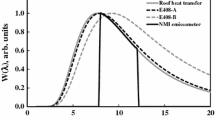Abstract
The external fueltank of the Space Shuttle contains extremely lowtemperature propellents. A layer of material known as SOFI (Spray-On Foam Insulation) covering the outside of the fueltank provides thermal insulation between the aluminum surface of the fueltank and the ambient air. In spite of this insulation, under certain conditions ice formation will occur on the surface of the SOFI. Ice on the external fueltank can be detrimental to the launch and it is important to detect its presence and measure its thickness. This paper describes the design of a millimeter-wave radiometer technique developed for this purpose. The design is based on model calculations and measurements of the emission properties of a panel from the external fueltank performed at 35, 94 and 140 GHz. Two sets of measurements were performed, one for the unmodified rough-surface SOFI panel and another for a panel whose surface was sanded down to produce a smooth surface interface with the ice cover. The latter was used to evaluate the results of radiative transfer calculations which are much easier to perform for multilayer structures with plane boundaries. We present experimental evidence demonstrating that the technique developed can accurately predict ice thickness in the case of the smooth-surface SOFI panel. For the original (rough-surface) panel, the emission levels observed were considerably higher than predicted by the model. Both cases however exhibited comparable sensitivities to ice thickness (∼ K/mm at 35 GHz, 4 K/mm at 94 GHz, and 5 K/mm at 140 GHz).
Similar content being viewed by others
References
Ulaby, F.T., R.K. Moore, and A.K. Fung,Microwave Remote Sensing, vol. 3, Artech House, Dedham, Mass., 1986.
Wu, S., NASA Stennis Research Center, personal communication.
Mätzler, C., and U. Wegmüller, “Dielectric Properties of Fresh Water Ice at Microwave Frequencies,”J. Phys. D: Applied Physics, vol. 20, 1987, pp. 1623–1630.
Ulaby, F.T., R.K. Moore, and A.K. Fung,Microwave Remote Sensing, vol. 1, Addison-Wesley, Reading, Mass., Ch. 4, 1981.
Ulaby, F.T., J.R. Kendra, T. Haddock, and S. Wu, “A Millimeter-Wave Radiometer Technique for Measuring Ice Thickness on the Surface of the Space Shuttle's External Fueltank,” Radiation Lab Report 027595-F, The University of Michigan, February, 1991.
Ulaby, F.T., R.K. Moore, and A.K. Fung,Microwave Remote Sensing, vol.2, Addison-Wesley, Reading, Mass., Ch. 12, 1982.
Author information
Authors and Affiliations
Rights and permissions
About this article
Cite this article
Kendra, J.E., Ulaby, F.T. & Wu, S. A millimeter wave technique for measuring ice thickness on the Space Shuttle's external tank. Int J Infrared Milli Waves 12, 1349–1377 (1991). https://doi.org/10.1007/BF01883870
Received:
Issue Date:
DOI: https://doi.org/10.1007/BF01883870




